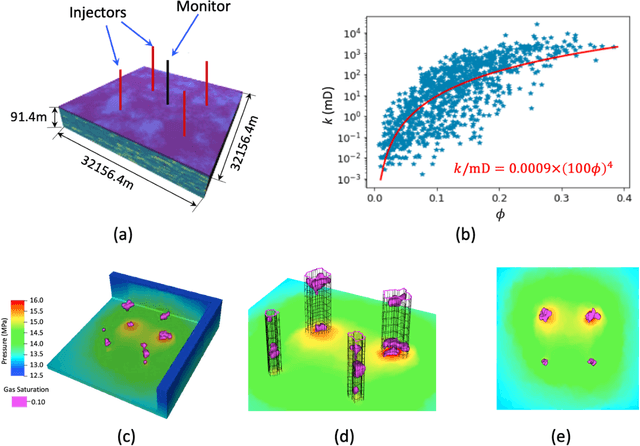Joseph P. Morris
Multi-fidelity Fourier Neural Operator for Fast Modeling of Large-Scale Geological Carbon Storage
Aug 23, 2023



Abstract:Deep learning-based surrogate models have been widely applied in geological carbon storage (GCS) problems to accelerate the prediction of reservoir pressure and CO2 plume migration. Large amounts of data from physics-based numerical simulators are required to train a model to accurately predict the complex physical behaviors associated with this process. In practice, the available training data are always limited in large-scale 3D problems due to the high computational cost. Therefore, we propose to use a multi-fidelity Fourier Neural Operator to solve large-scale GCS problems with more affordable multi-fidelity training datasets. The Fourier Neural Operator has a desirable grid-invariant property, which simplifies the transfer learning procedure between datasets with different discretization. We first test the model efficacy on a GCS reservoir model being discretized into 110k grid cells. The multi-fidelity model can predict with accuracy comparable to a high-fidelity model trained with the same amount of high-fidelity data with 81% less data generation costs. We further test the generalizability of the multi-fidelity model on a same reservoir model with a finer discretization of 1 million grid cells. This case was made more challenging by employing high-fidelity and low-fidelity datasets generated by different geostatistical models and reservoir simulators. We observe that the multi-fidelity FNO model can predict pressure fields with reasonable accuracy even when the high-fidelity data are extremely limited.
Deep Learning-Accelerated 3D Carbon Storage Reservoir Pressure Forecasting Based on Data Assimilation Using Surface Displacement from InSAR
Jan 27, 2022



Abstract:Fast forecasting of reservoir pressure distribution in geologic carbon storage (GCS) by assimilating monitoring data is a challenging problem. Due to high drilling cost, GCS projects usually have spatially sparse measurements from wells, leading to high uncertainties in reservoir pressure prediction. To address this challenge, we propose to use low-cost Interferometric Synthetic-Aperture Radar (InSAR) data as monitoring data to infer reservoir pressure build up. We develop a deep learning-accelerated workflow to assimilate surface displacement maps interpreted from InSAR and to forecast dynamic reservoir pressure. Employing an Ensemble Smoother Multiple Data Assimilation (ES-MDA) framework, the workflow updates three-dimensional (3D) geologic properties and predicts reservoir pressure with quantified uncertainties. We use a synthetic commercial-scale GCS model with bimodally distributed permeability and porosity to demonstrate the efficacy of the workflow. A two-step CNN-PCA approach is employed to parameterize the bimodal fields. The computational efficiency of the workflow is boosted by two residual U-Net based surrogate models for surface displacement and reservoir pressure predictions, respectively. The workflow can complete data assimilation and reservoir pressure forecasting in half an hour on a personal computer.
A Deep Learning-Accelerated Data Assimilation and Forecasting Workflow for Commercial-Scale Geologic Carbon Storage
May 09, 2021



Abstract:Fast assimilation of monitoring data to update forecasts of pressure buildup and carbon dioxide (CO2) plume migration under geologic uncertainties is a challenging problem in geologic carbon storage. The high computational cost of data assimilation with a high-dimensional parameter space impedes fast decision-making for commercial-scale reservoir management. We propose to leverage physical understandings of porous medium flow behavior with deep learning techniques to develop a fast history matching-reservoir response forecasting workflow. Applying an Ensemble Smoother Multiple Data Assimilation framework, the workflow updates geologic properties and predicts reservoir performance with quantified uncertainty from pressure history and CO2 plumes interpreted through seismic inversion. As the most computationally expensive component in such a workflow is reservoir simulation, we developed surrogate models to predict dynamic pressure and CO2 plume extents under multi-well injection. The surrogate models employ deep convolutional neural networks, specifically, a wide residual network and a residual U-Net. The workflow is validated against a flat three-dimensional reservoir model representative of a clastic shelf depositional environment. Intelligent treatments are applied to bridge between quantities in a true-3D reservoir model and those in a single-layer reservoir model. The workflow can complete history matching and reservoir forecasting with uncertainty quantification in less than one hour on a mainstream personal workstation.
 Add to Chrome
Add to Chrome Add to Firefox
Add to Firefox Add to Edge
Add to Edge